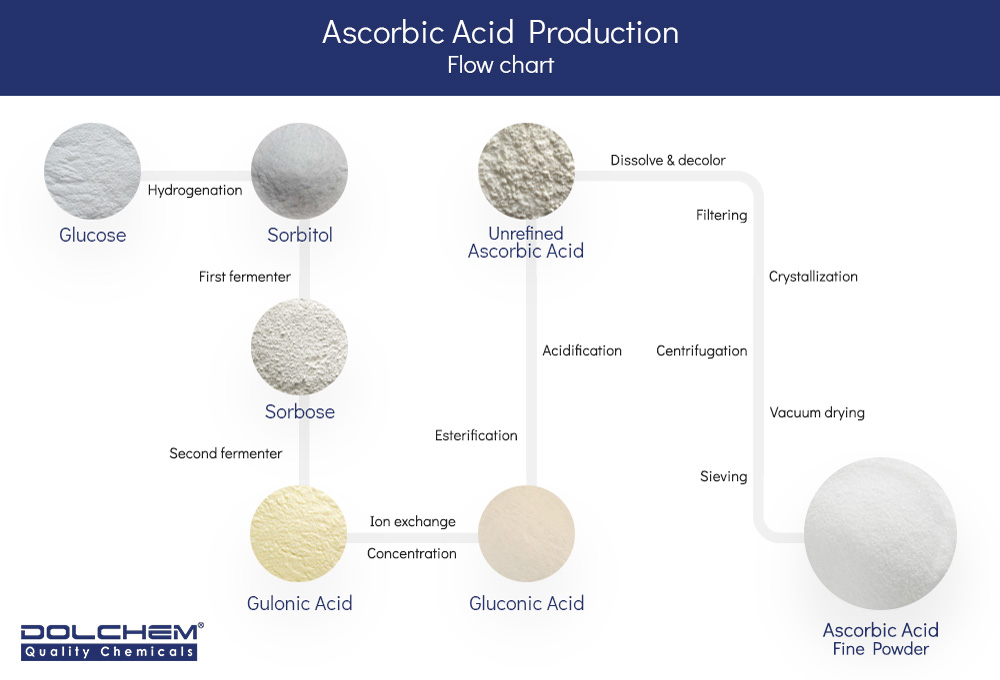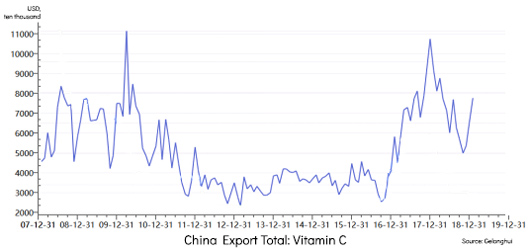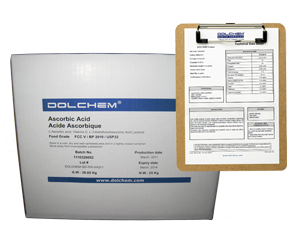Since 1933, the year when Ascorbic Acid was synthesized in laboratory conditions, its commercial production has started and been continued. It is an irreplaceable and safe material that is manufactured, sold, bought, traded and used daily. What is the journey of Ascorbic Acid from the production line and up to the end product? The DOLCHEM team combines its experience, manufacturers’ knowledge and scientific resources to outline all the aspects.
How Ascorbic Acid is produced?
While Ascorbic Acid is found naturally in many fruits (guavas, kiwis, not to mention any citruses, etc), plants and vegetables (bell pepper, kale, broccoli, etc), it is rarely extracted from these sources on an industrial scale, because the production cost would be too high. Instead, there’s a chemical process, proven by years and adopted, that allows manufacturers efficiently produce this raw material by treating other compounds. The process starts with the hydrogenation of Glucose, which thereby becomes Sorbitol. After, the conversion of Sorbitol into Sorbose takes place during the first fermentation, the second fermentation leads to the formation of Gulonic Acid. Gulonic Acid undergoes the process of ion exchange and concentration into Gluconic Acid, which then, during a sequence of treating procedures, becomes Ascorbic Acid. See more in the chart:

Most of these materials are already sufficient raw materials and used as additives as well. Glucose powder is a commonly used food additive, Sorbitol is a liquid material with a wide range of applications in pharma and food industries, and Gluconic Acid is frequently applied not only in the food industry but in cosmetics, medicine, and metal treatment as well.
What are the forms of Ascorbic Acid?
Initially manufactured Ascorbic Acid is in powder or crystal form because it is obtained in a process of liquid crystallization. So, the pure Ascorbic Acid is fine and white powder, sometimes it could have a yellowish shade. However, later on, different forms of Ascorbic Acid can be made based on the final use. The liquid solutions of Ascorbic Acid are possible due to its solubility in water and in ethanol. Ascorbic Acid in a capsules (tablets) form is usually a complete preparation when other materials such as microcrystalline cellulose are added for better compression. Thus, manufacturers of Ascorbic Acid mostly offer powder forms, some expend their offers with liquid solutions, but pills and injection matters of Vitamin C are purely pharma products and must be provided by certified entities.
What is the difference between L Ascorbic Acid and Ascorbic Acid?
L-Ascorbic Acid and Ascorbic Acid are essentially the same substance, and it’s just one of the terms. Ascorbic Acid has many other names, from the formal chemical Ferrous ascorbate to the most common name – Vitamin C.
What is the difference between Ethyl Ascorbic Acid and Ascorbic Acid?
Ethyl Ascorbic Acid powder is a form of Vitamin C, treated with compounds of the ethyl group to create stable cosmetic products.
What are the most common applications of Ascorbic Acid?
Ascorbic Acid is a green circle ingredient in The Safer Chemical Ingredients List (SCIL), its functional use is defined as processing aids and additives, the list of its applications is the following:
- Food and beverages processing (about 60%)
- Preservative (essential additive in bakery)
- Acidity Regulator
- Color fixative
- and more
- Pharmaceutical and medicine manufacturing (about 30%)
- Nutrition supplement (Vitamin C)
- IV Vitamin C (injections)
- Cosmetics
- skin lightening preparations
- protective creams.
Some extra and less obvious applications, less known and rarely used because there usually are better cost-effective alternatives:
- Tobacco product manufacturing (Ascorbic Acid can be used in the treatment of smoking materials)
- Water treatment (water dichlorination and drinking water purification)
- Photo processing and printing (Ascorbic Acid might be used as a component of film emulsions and developers both in color and black&white photography; a component of the developers used in lithography)
- Metal treatment and coating, electroplating (oxidation control, rust removing and proofing applications)
- Polymerization reactions in the plastics industry
- and more.
Where to buy Ascorbic Acid in bulk?
First of all, there are several countries where Ascorbic Acid powder is produced, with the major part of Ascorbic Acid coming from China. The plants continuously improve the process, equipment and obtain all the necessary certifications such as Kosher and Halal, and follow USP, FCC, EP, BP and JP standards.
Depending on your needs, you might find various options. If your business needs start from about 10MT, you might consider sourcing from China directly, because it’s cost-effective. However, it is extremely important to make sure that the supplier of Ascorbic Acid you are about to choose is trustworthy and will deliver quality products on time. In case when you need more food additives in addition to Ascorbic Acid, the DOLCHEM® team can provide you with a mixed container of food and beverages additives.
What is Ascorbic Acid 99% price?
The market of Ascorbic Acid is quite competitive, and the prices of directly sourced Ascorbic Acid are updated daily. Historic records show that the price fluctuates between $3-$10 per kilo. The exported volume also differs with no particular pattern for low or high season in demand for Ascorbic Acid.

When you are sure what additives you need, the next step is to choose the right supplier. Finding the additives that match your quality is easier with an experienced raw materials provider – DOLCHEM®. Get in touch for more details and further discussion:
Valuable sources:
- Bauernfeind, J. C. (1982). Ascorbic Acid Technology in Agricultural, Pharmaceutical, Food, and Industrial Applications. Advances in Chemistry, 395–497. doi:10.1021/ba-1982-0200.ch020
- Nermin M. Yussif (2018) Vitamin C. doi: 10.5772/intechopen.81783
- Lim, S.M., Lau, M.S.L., Tiong, E.I.J. et al. (2020) Process design and economic studies of two-step fermentation for production of ascorbic acid. SN Appl. Sci. 2, 816. doi: 10.1007/s42452-020-2604-8
